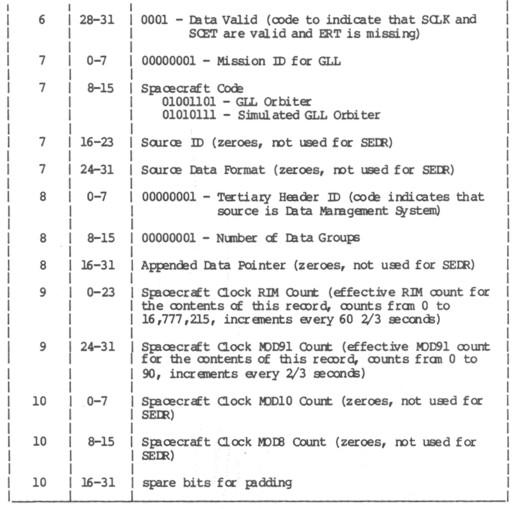The Galileo Energetic Particles Detector
Galileo EPD Handbook
Appendices
Appendix B. SEDR Files (continued)
Source: J. F. Schmidling, JPL 625-610, SIS 224-09, Phase 2 Rev., 6/21/85
4. Detailed Interface Specifications
Structure and Organization Overview
F&P SEDR data files shall be delivered or made available differently depending upon whether the data is being provided by GSOC or JPL. GSOC provided SEDRs shall be contained as the second file on the same physical magnetic tape that contains the corresponding EDR data. JPL SEDRs shall be written as a single file to a magnetic tape. The following figures illustrate how the F&P SEDR data shall be made available to PIs from either GSOC or JPL.
Figure 1. Magnetic Tape Layout - GSOC EDR/SEDR
| Standard Label | EOF | EDR File | EOF | SEDR FILE | EOF | EOF |
Figure 2. Magnetic Tape Layout - JPL SEDR
| SEDR File | EOF | EOF |
The file or database of SEDR logical records shall be arranged in ascending SCET order at a record frequency which satisfies the highest requirement negotiated between the Galileo Data Management Team (DMT) and the F&P instrument PIs. The actual layout of the SEDR file received from either GSOC or JPL shall be identical and is illustrated in Figure 3.
Figure 3. SEDR File Layout
| First Logical Record |
| IRG |
| Second Logical Record |
| IRG |
| · · · |
| IRG |
| Last Logical Record |
| EOF |
| EOF |
Each F&P SEDR file shall contain a series of logical records each of which defines the set of required SEDR parameters at a given point in time. Each logical record shall contain a set of SFDU headers followed by one or two SEDR data blocks. The two SEDR data blocks are the Interplanetary Cruise (IC) SEDR Data Block and the Jupiter Orbital Operations (JO) SEDR Data Block. GSOC generated SEDRs shall contain only the IC block, while JPL generated SEDRs may contain the IC block or both the IC and JO blocks. In general, the IC block contains all SEDR parameters which are interplanetary in nature and are required to process EDR data during the interplanetary cruise science phase of the mission. The JO block provides additional SEDR parameters that define the geometry of the Jovian system in several coordinate systems and are required to process the science data received during the Jupiter orbital mission phase. Figure 4 presents the general structure of each SEDR logical record.
Figure 4. SEDR Logical Record Structure
| Primary SFDU Header |
| Secondary SFDU Header |
| Tertiary SFDU Header |
| Interplanetary Cruise SEDR
Data Block (GSOC and JPL) |
| Jupiter Orbital SEDR Data
Block (JPL Only) |
Substructure Definition and Format
The following paragraphs provide the detailed format specification for the SFDU headers and the SEDR data blocks. All SEDR words are 32 bits in length. The first word of each logical record (the first 32 bits of the primary SFDU header) shall be referred to word number 1 and all subsequent words in the logical record shall be sequentially numbered in increasing monatomic order as referenced to this first word.
SFDU Header Formats. The combined format of the primary and secondary SFDU headers is presented in Figure 5 and is specified in detail in Table 1. The tertiary header format is presented in Figure 6 and is specified in detail in Table 2. The figures provide a layout of the header fields and the bits they occupy along with the generic name identifiers associated with each field. The tables identify the beginning and ending word and bit locations of each header field along with the generic name and a detailed description of the exact meaning and application of that field.
Figure 5. Primary/Secondary SFDU Header Format

Table 1. Primary/Secondary SFDU Header Specification


Figure 6. Tertiary SDFC Header Format

Table 2. Tertiary SFDU Header Specification

Return to Galileo EPD Handbook Table of Contents Page.
Return to main
Galileo Table of Contents Page.
Return to Fundamental
Technologies Home Page.
Updated 8/23/19, Cameron Crane
QUICK FACTS
Mission Duration: Galileo was planned to have a mission duration of around 8 years, but was kept in operation for 13 years, 11 months, and 3 days, until it was destroyed in a controlled impact with Jupiter on September 21, 2003.
Destination: Galileo's destination was Jupiter and its moons, which it orbitted for 7 years, 9 months, and 13 days.



